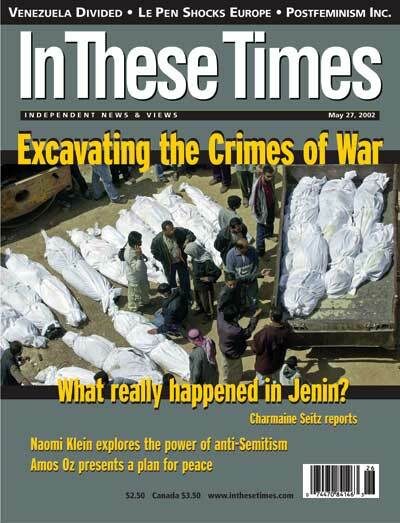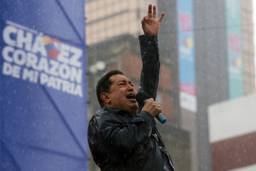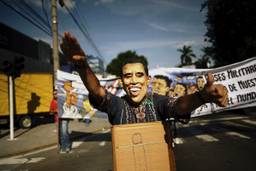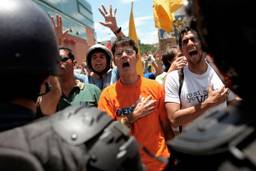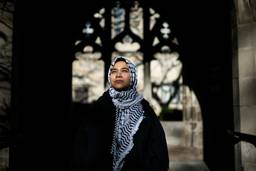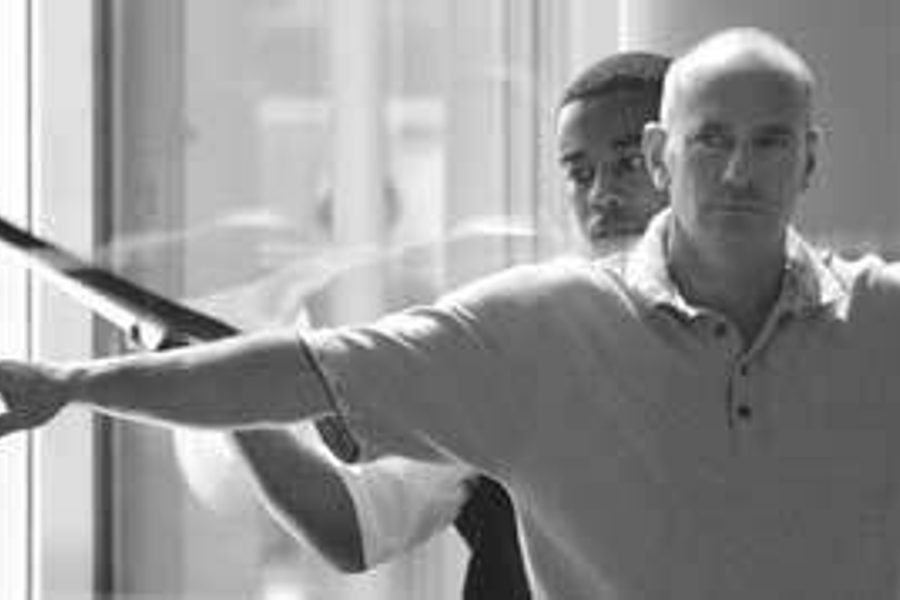
Caracas, Venezuela
Culminating three days of a general strike and violence on the streets of Caracas that left scores of casualties, the Venezuelan military forced President Hugo Chávez from office. The action did not come as a surprise, given the increasing aggressiveness of the opposition, which includes Venezuelas largest business and labor organizations, media outlets and political parties. But then a counter-coup, which ousted provisional President Pedro Carmona and invited Chávez back to power, surprised the entire nation and the world. Political satirists now call Carmona, who was in power less than 48 hours, Pedro the Brief.
When the fiery Chávez returned to power, he might have been expected to come down hard on his adversaries, especially those who had accepted positions in the interim government. But when the weary-eyed leader arrived at the presidential palace in the wee hours of the morning of April 14, he immediately took a conciliatory tone.
In a press conference the next day, Chávez pledged himself to rectification, called on his adversaries to do the same, and exhorted the media to show greater impartiality. Chávez admitted his error in firing seven top executives of the state-run oil firm, who had instigated a slowdown to protest the alleged infiltration of the company by Chávez backers. He also apologized to two leading journalists, who had been critical of his government, for having disparaged their dead fathers. Finally, he recognized that his aggressive style had led to unnecessary clashes with other institutions such as the Catholic Church.
While the president of the national labor confederation and other members of the opposition have accepted the presidents call for dialogue, others continue to insist on Chávezs exit from power and propose a national referendum to decide the matter. They argue that the massive anti-government march of 300,000 people (whose size has been exaggerated in both directions) on the day of the coup represented a plebiscite in favor of Chávezs removal. But the opposite can also be argued. Opposition leaders fail to acknowledge that the poor, who took to the streets demanding Chávezs return to power, outnumber the middle classfive to one.
————–
The polarization that pit the pro-Chavista poor against the anti-Chavistas reached a peak during the events leading up to the coup. For several previous months, street mobilizations against Chávez were a regular phenomenon in the affluent, eastern part of Caracas. But equal numbers of Venezuelans turned out to show their support for the president, usually in the poverty-stricken west and downtown areas.
Fedecamaras, the nations main business organization, headed by Carmona, and the national leadership of the main labor confederation, the Confederation of Venezuelan Workers, led the anti-Chávez protests. On April 9, the two organizations called a 24-hour general strike, which continued indefinitely. On the third day, they organized a march from the wealthy western sectors of Caracas toward the presidential palace to demand Chávezs resignation. The turnout was far greater than expected.
Once downtown, gunfire broke out resulting in scores of casualties and 17 deaths, both protesters and Chavistas. The firing came from three sources: a group of government supporters, police who were in between the pro- and anti-Chavistas, and from snipers in the buildings overlooking both gatherings. Exactly who began the shooting has yet to be determined. The opposition blames Chavista paramilitary groups, while the presidents supporters claim that the reactionary Red Flag Party and Caracas police (under the direction of the citys anti-Chavista mayor) opened fire first.
Top military officers declared that they would not repress the people, and, to avoid further disorder, they arrested Chávez and turned power over to Carmona. Some of the presidents military supporters wanted to fight back, but Chávez insisted on avoiding bloodshed. Just why Carmona ended up as provisional president is still a matter of speculation. But business representatives and several conservative politicians predominated in his new government. Many officers who had been assured that the military and popular leaders would be equally represented quickly expressed misgivings.
Carmona immediately decreed the abolition of democratic institutions such as the National Assembly, and granted himself the right to select and remove governors and mayors. Another decree suspended a series of laws passed by Chávez. Carmona promised to hold elections within one year and not to run as a presidential candidate. He justified these moves by claiming that the people had given him a popular mandate.
It was as if the Bourbons had returned to the throne. On the evening of April 12, Carmonas first day in office, anti-Chavista journalist and ex-politician Teodoro Petkoff called the new government plutocratic on national television. The following day a neutral, pro-democratic current in the armed forces united with the Chavistas, who were strongest among mid-level officers, and took control of military installations throughout the country. Carmona, who was in Caracas Fort Tiuna to swear in the new military command, was forced to publicly resign and announce his acceptance of Chávezs return.
The stark contrast between the haves and have-nots was especially evident in their reactions to the coup. The enormous march that led to Chávezs overthrow consisted of members of the upper and middle classes. But on the night of Carmonas first day in office, poor people banged on pots and pans from their windows, a protest that has come to signify opposition to government. The following day the poor came down from the hills (as Venezuelans say), overtook the presidential palace and surrounded Fort Tiuna.
————–
Most politicians and political commentators here and abroad attribute the nations political crisis to Chávezs aggressive style, inflexibility and intolerance. While these traits certainly have aggravated tensions, they are not at the heart of the polarization that has overwhelmed the nation. Economic and class issues lurk just below the surface. Indeed, the agrarian reform, the state-run health system, modifications in the system of severance pay and other reforms enacted by Chávez have been popular banner issues going back more than 50 years, and have always been staunchly opposed by the business elite.
Last year, the economic stagnation and decline of oil prices thrust economic issues onto center stage. The opposition parties went on the offensive, particularly after September 11. Not only did they accuse Chávez of being anti-American due to his opposition to the U.S. bombing of Afghanistan, but held him responsible for the dearth of foreign investments in Venezuela because of his radical language and confrontational style. Chávez reacted by radicalizing his own positions. In November, Chávez pushed through 49 laws in one fell swoop. Among them were far-reaching reforms such as a law that prohibited foreign control of oil-producing operations and an agrarian reform that threatened property owners with land redistribution.
Business spokesmen accused Chávez of railroading this legislation through Congress, which he had converted into a rubber-stamp body. The criticism had validity. Chávez failed to barnstorm the nation to educate the public and generate enthusiasm for the measures, as he had two years earlier for ratification of a new constitution. Such a strategy might have strengthened Chávezs position against the interest groups opposed to his legislation. But business groups did not oppose the laws because Chávez had violated democratic procedures or used offensive language. The content of the legislation is what mattered.
The Venezuelan media also vehemently oppose Chávez. During the three-day strike, the national TV channels suspended their regular programming and exclusively broadcast the anti-government point of view. On April 12, the day Carmonas de facto government was installed, well-known Chavistas were physically attacked by mobs outside their homes and hauled off by police. Television showed appalling images of a throng of middle-class Venezuelans grabbing the hair of Minister of Interior Ramón Rodríguez Chacín and shouting handcuff him, as police escorted him to a paddy wagon. The national networks, which prior to the coup had condemned Chavista gatherings for clashing with anti-government protesters on the streets, made no comments about these persecutions.
————–
In a typical blame-the-victim line of reasoning, President Bush attributed the coup to Chávezs poor rule. Washington carefully avoided the term coup and instead referred to those who replaced Chávez as a transitional government. Far more troublesome is evidence that the White House actually encouraged the military to act. A Defense Department official told the New York Times that members of the Bush administration had met with conspirators prior to the coup: We were not discouraging people. We were sending informal, subtle signals that we dont like this guy. We didnt say, No, dont you dare, and we werent advocates saying, Heres some arms; well help you overthrow this guy.
In Caracas, three deputies belonging to Chávezs party claim to have proof implicating U.S. officials in the coup attempt. One of the deputies, Juan Barreto, declared: It is very probable that some sectors of the U.S. government, confused and without official authorization, aided the coup, but I do not believe that the U.S. government itself is an enemy of Venezuela.
At a press conference on Chávezs second day back in power, a foreign journalist asked the president if he thought he was overthrown because he had strayed too far from the Washington consensus. Chávez avoided answering the question directly and responded by reaffirming Venezuelas democratic credentials. Several days later, Chávez stated that he preferred to give the Washington the benefit of the doubt and did not want to take for granted … the veracity of published information regarding U.S. involvement.
Chávezs new tone may signal that his revolution has reverted to a more moderate stage. His restrained language could spell the opening of a national debate in which the middle class, among others, discuss the complexity of the predicaments facing the nation. If so, this would be fortunate for Venezuela. Because if a revolution is underway, as the Chavistas claim, it is not about style and rhetoric, but rather about the pressing social and economic divide.
Culminating three days of a general strike and violence on the streets of Caracas that left scores of casualties, the Venezuelan military forced President Hugo Chávez from office. The action did not come as a surprise, given the increasing aggressiveness of the opposition, which includes Venezuelas largest business and labor organizations, media outlets and political parties. But then a counter-coup, which ousted provisional President Pedro Carmona and invited Chávez back to power, surprised the entire nation and the world. Political satirists now call Carmona, who was in power less than 48 hours, Pedro the Brief.
When the fiery Chávez returned to power, he might have been expected to come down hard on his adversaries, especially those who had accepted positions in the interim government. But when the weary-eyed leader arrived at the presidential palace in the wee hours of the morning of April 14, he immediately took a conciliatory tone.
In a press conference the next day, Chávez pledged himself to rectification, called on his adversaries to do the same, and exhorted the media to show greater impartiality. Chávez admitted his error in firing seven top executives of the state-run oil firm, who had instigated a slowdown to protest the alleged infiltration of the company by Chávez backers. He also apologized to two leading journalists, who had been critical of his government, for having disparaged their dead fathers. Finally, he recognized that his aggressive style had led to unnecessary clashes with other institutions such as the Catholic Church.
While the president of the national labor confederation and other members of the opposition have accepted the presidents call for dialogue, others continue to insist on Chávezs exit from power and propose a national referendum to decide the matter. They argue that the massive anti-government march of 300,000 people (whose size has been exaggerated in both directions) on the day of the coup represented a plebiscite in favor of Chávezs removal. But the opposite can also be argued. Opposition leaders fail to acknowledge that the poor, who took to the streets demanding Chávezs return to power, outnumber the middle classfive to one.
————–
The polarization that pit the pro-Chavista poor against the anti-Chavistas reached a peak during the events leading up to the coup. For several previous months, street mobilizations against Chávez were a regular phenomenon in the affluent, eastern part of Caracas. But equal numbers of Venezuelans turned out to show their support for the president, usually in the poverty-stricken west and downtown areas.
Fedecamaras, the nations main business organization, headed by Carmona, and the national leadership of the main labor confederation, the Confederation of Venezuelan Workers, led the anti-Chávez protests. On April 9, the two organizations called a 24-hour general strike, which continued indefinitely. On the third day, they organized a march from the wealthy western sectors of Caracas toward the presidential palace to demand Chávezs resignation. The turnout was far greater than expected.
Once downtown, gunfire broke out resulting in scores of casualties and 17 deaths, both protesters and Chavistas. The firing came from three sources: a group of government supporters, police who were in between the pro- and anti-Chavistas, and from snipers in the buildings overlooking both gatherings. Exactly who began the shooting has yet to be determined. The opposition blames Chavista paramilitary groups, while the presidents supporters claim that the reactionary Red Flag Party and Caracas police (under the direction of the citys anti-Chavista mayor) opened fire first.
Top military officers declared that they would not repress the people, and, to avoid further disorder, they arrested Chávez and turned power over to Carmona. Some of the presidents military supporters wanted to fight back, but Chávez insisted on avoiding bloodshed. Just why Carmona ended up as provisional president is still a matter of speculation. But business representatives and several conservative politicians predominated in his new government. Many officers who had been assured that the military and popular leaders would be equally represented quickly expressed misgivings.
Carmona immediately decreed the abolition of democratic institutions such as the National Assembly, and granted himself the right to select and remove governors and mayors. Another decree suspended a series of laws passed by Chávez. Carmona promised to hold elections within one year and not to run as a presidential candidate. He justified these moves by claiming that the people had given him a popular mandate.
It was as if the Bourbons had returned to the throne. On the evening of April 12, Carmonas first day in office, anti-Chavista journalist and ex-politician Teodoro Petkoff called the new government plutocratic on national television. The following day a neutral, pro-democratic current in the armed forces united with the Chavistas, who were strongest among mid-level officers, and took control of military installations throughout the country. Carmona, who was in Caracas Fort Tiuna to swear in the new military command, was forced to publicly resign and announce his acceptance of Chávezs return.
The stark contrast between the haves and have-nots was especially evident in their reactions to the coup. The enormous march that led to Chávezs overthrow consisted of members of the upper and middle classes. But on the night of Carmonas first day in office, poor people banged on pots and pans from their windows, a protest that has come to signify opposition to government. The following day the poor came down from the hills (as Venezuelans say), overtook the presidential palace and surrounded Fort Tiuna.
————–
Most politicians and political commentators here and abroad attribute the nations political crisis to Chávezs aggressive style, inflexibility and intolerance. While these traits certainly have aggravated tensions, they are not at the heart of the polarization that has overwhelmed the nation. Economic and class issues lurk just below the surface. Indeed, the agrarian reform, the state-run health system, modifications in the system of severance pay and other reforms enacted by Chávez have been popular banner issues going back more than 50 years, and have always been staunchly opposed by the business elite.
Last year, the economic stagnation and decline of oil prices thrust economic issues onto center stage. The opposition parties went on the offensive, particularly after September 11. Not only did they accuse Chávez of being anti-American due to his opposition to the U.S. bombing of Afghanistan, but held him responsible for the dearth of foreign investments in Venezuela because of his radical language and confrontational style. Chávez reacted by radicalizing his own positions. In November, Chávez pushed through 49 laws in one fell swoop. Among them were far-reaching reforms such as a law that prohibited foreign control of oil-producing operations and an agrarian reform that threatened property owners with land redistribution.
Business spokesmen accused Chávez of railroading this legislation through Congress, which he had converted into a rubber-stamp body. The criticism had validity. Chávez failed to barnstorm the nation to educate the public and generate enthusiasm for the measures, as he had two years earlier for ratification of a new constitution. Such a strategy might have strengthened Chávezs position against the interest groups opposed to his legislation. But business groups did not oppose the laws because Chávez had violated democratic procedures or used offensive language. The content of the legislation is what mattered.
The Venezuelan media also vehemently oppose Chávez. During the three-day strike, the national TV channels suspended their regular programming and exclusively broadcast the anti-government point of view. On April 12, the day Carmonas de facto government was installed, well-known Chavistas were physically attacked by mobs outside their homes and hauled off by police. Television showed appalling images of a throng of middle-class Venezuelans grabbing the hair of Minister of Interior Ramón Rodríguez Chacín and shouting handcuff him, as police escorted him to a paddy wagon. The national networks, which prior to the coup had condemned Chavista gatherings for clashing with anti-government protesters on the streets, made no comments about these persecutions.
————–
In a typical blame-the-victim line of reasoning, President Bush attributed the coup to Chávezs poor rule. Washington carefully avoided the term coup and instead referred to those who replaced Chávez as a transitional government. Far more troublesome is evidence that the White House actually encouraged the military to act. A Defense Department official told the New York Times that members of the Bush administration had met with conspirators prior to the coup: We were not discouraging people. We were sending informal, subtle signals that we dont like this guy. We didnt say, No, dont you dare, and we werent advocates saying, Heres some arms; well help you overthrow this guy.
In Caracas, three deputies belonging to Chávezs party claim to have proof implicating U.S. officials in the coup attempt. One of the deputies, Juan Barreto, declared: It is very probable that some sectors of the U.S. government, confused and without official authorization, aided the coup, but I do not believe that the U.S. government itself is an enemy of Venezuela.
At a press conference on Chávezs second day back in power, a foreign journalist asked the president if he thought he was overthrown because he had strayed too far from the Washington consensus. Chávez avoided answering the question directly and responded by reaffirming Venezuelas democratic credentials. Several days later, Chávez stated that he preferred to give the Washington the benefit of the doubt and did not want to take for granted … the veracity of published information regarding U.S. involvement.
Chávezs new tone may signal that his revolution has reverted to a more moderate stage. His restrained language could spell the opening of a national debate in which the middle class, among others, discuss the complexity of the predicaments facing the nation. If so, this would be fortunate for Venezuela. Because if a revolution is underway, as the Chavistas claim, it is not about style and rhetoric, but rather about the pressing social and economic divide.
Steve Ellner, who began teaching at the Universidad de Oriente in Venezuela in 1977, is currently an adjunct professor of International and Public Affairs at Columbia University’s. His latest book is Rethinking Venezuelan Politics: Class, Conflict and the Chavez Phenomenon (Lynne Rienner Publishers).
